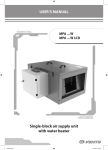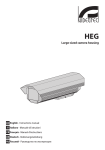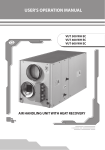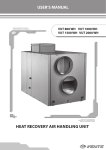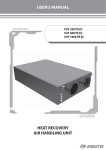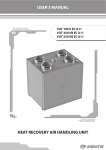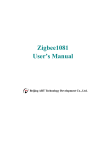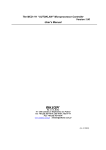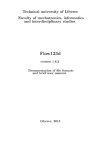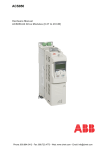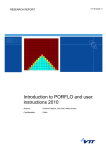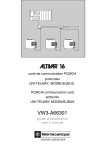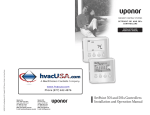Download "Control and automation block for VENTS PA W" ( PDF 1,61Mb )
Transcript
Operation Manual PA 01W PA 02W PA 03W PA 04W Automatic Control System for Air Supply Ventilation Unit with Hydronic Coil Heat Exchanger 2 PA W Contents General description Technical Specifications Safety Requirements Functional Diagram ACS DESIGN AND OPERATION Safety Precautions Controller Function Set Remote control External Connections Diagram General Operation Guidelines Transportation and Storage Safety Precautions Manufacturer’s Warranty Acceptance Certificate Connection Certificate Warranty Card 3 4 4 5 5 7 10 14 15 18 18 19 19 20 20 20 3 GENERAL DESCRIPTION The present technical specification is intended for technicians and engineers involved in design, installation and setup of ventilation equipment automation systems. The General Operation Guidelines (see. Page 18) are intended for end users. Following the control unit operation and maintenance instructions is a prerequisite of its troublefree operation and long service life. The automatic control system (Fig. 1) is designed for integrated management and control of ventilation and air conditioning systems. The device is enclosed in a plastic casing. The control unit casing contains automatic equipment circuitry of the as well as control and protective elements of the power components. The regulating functionality is implemented by means of a programmable controller. The control unit is suitable for indoor installation in a dust-free dry environment free from chemical contaminants. The control unit casing meets IP65 standard (units PA 01 W, PA 02 W and PA 03 W) and IP54 standard (unit PA 04 W) with the top lid closed. The permissible ambient temperature during operation is from +5 °С to +40 °С. TE5 TE1 P1 PD1 Control Unit PD1 - pressure safety switch. P1 - remote control. TE1 - ambient temperature sensor. TE5 - supply air temperature sensor. Fig. 1 The electronic ACS automatic control and monitoring unit performs a number of functions - in particular: 1. Switching the unit electric motor on and off. 2. Selecting the fan speed (3 settings). 3. Air supply fan operation control and monitoring. 4. Maintaining the supply air temperature at the pre-set level by actuating the three-way valve which adjusts the heat-transfer medium delivery into the heating coils. 5. Protecting the hydronic coil heater against freezing (using the input data from the downstream air temperature and return water temperature sensors). 6. Monitoring and control over the operation of the circulation pump delivering the heat transfer agent to the heating coils. 4 PA W 7. Control of the air cooler compressor and condenser unit (CCU) using the pre-set temperature. 8. Filter contamination control. 9. Control of of the external air damper electric actuator; 10. System shutdown on command from the fire alarm panel. TECHNICAL SPECIFICATIONS The main technical specifications are given in Table 1. Table 1 PA 01W PA 02W PA 03W Supply Voltage, V / 50 Hz 1~230 Operating Voltage of Plugged-in Electric Motor, V 3~230 PA 04W Motor Power Consumption (max.), kW 0,75 1,1 1,5 2,2 Motor Current Consumption (max.), A 3,5 5,5 7,5 10 340 340 340 500 Width 280 280 280 400 Depth 135 135 135 250 Dimensions, mm Control Unit Dimensions, mm Height Weight, kg Рабочая температура окружающего воздуха, °С Not more than 6 from +5 to +40 Permissible Relative Humidity, % Protection class (top lid closed) Not more than 11 80 IP65 IP54 SAFETY REQUIREMENTS Installation and operation of the automatic equipment shall be subject to the present User’s Operation Manual, «Electrical Installations Code», «Regulations for Customer’s Electric Installations Operation», the current construction norms and regulations, and the provisions of «Fire Safety Regulations in Ukraine». ATTENTION! The Automatic Control System is to be connected by duly qualified technicians with appropriate work permits. Disconnect the automatic equipment from the power mains prior to any installation, maintenance, connection and repair work. • RESTRICTIONS Do not operate the Automatic Control System outside the permissible temperature range specified in the User’s Operation Manual or in areas with aggressive admixtures in the air and in explosive environments. 5 FUNCTIONAL DIAGRAM Indoors Outdoors CCU Digital Input Digital Output Analogue Input Analogue Output Design. Designation ATV1 Frequency Transformer. DD1 Pump dry running relay. PD1 Pressure safety switch on supply air filter. F1 Supply air filter. M1 Supply fan. M2 Circulation Pump. P1 Control panel. Q1 Hydronic Coil Heat Exchanger. Q2 Freon chiller. SM1 Supply air damper actuator. SM2 Three-way valve actuator. TE1 Ambient temperature sensor. TE3 Return water temperature sensor. TE4 Heat exchanger freezing protection sensor. TE5 Supply air temperature sensor. Fig. 2 AUTOMATIC CONTROL SYSTEM (ACS) DESIGN AND OPERATION The ACS operates in two modes: «Heating» or «Cooling». The «Heating» or «Cooling» mode is selected automatically according to the outdoor temperature. if the outdoor temperature is in excess of Тперех. parameter value (as set from the controller menu, Тперех. parameter (see Table 2), factory setting +5°С) the system runs in the «Cooling» mode whereas on temperature dropping below the Тперех. threshold value the system switches to the «Heating» mode. The fans are started and shut down using button (1) (see Fig. 10) on the control panel. The air flow (fan speed) is set by button (3) also located on the control panel (see Fig. 10) The controller activates and deactivates the water coil circulation pump, controls the heattransfer medium valve and opens and closes the ambient air damper automatically. In the «Cooling» mode the ACS additionally performs the following functions: When the fan is on the ACS maintains the supply air temperature at the pre-set level (set from the control panel) by actuating the water coil valve; On fan shutdown the ACS shuts off the water coil valve and closes the supply and exhaust air valves. 6 PA W In the «Heating» mode the ACS additionally performs the following functions: when the fan is on the ACS maintains the supply air temperature at the pre-set level (set from the control panel) by actuating the water coil valve; on fan activation command the ACS warms-up the water coils for n minutes (Warm-up Time parameter set from the controller menu (see Table 2), factory setting 180 s)prior to the fan start by means of complete opening the water coil valve. when the fan is off the ACS maintains the return water temperature downstream of the water coils at the pre-set minimum level of +20°С. In both «Heating» and «Cooling» modes ACS protects the water coils against freezing (using the input data from the air duct thermostat sownstream of the water coils). If freezing is imminent the control system automatically shuts down the fans, closes the ambient supply air damper, opens the water coil valve completely and activates the circulation pump. Circulation Pump Operation. In the ACS «Heating» or «Cooling» mode the circulation pump activates automatically while the fans are on or on water coil warm-up initialization and deactivates on fan switching off. While on standby the circulation pump activates on freezing danger detection irrespective of the ACS mode. When freezing is no longer imminent and upon emergency reset the circulation pump reverts to the pre-emergency state - i.e. continues operation or goes on standby. In either of the modes the circulation pump will not activate if the heattransfer medium pressure relay DD1 contacts are open. The pressure relay protects the circulation pump against «dry» running. If the water coil circuit is not equipped with pressure relay DD1 install a jumper wire on contacts 11-12 (see Fig. 11) and 14-15 (see Fig. 11) to enable the circulation pump operation. Circulation pump protection may not be guaranteed without a pressure relay. Compressor and Condenser Unit Operation To enable the CCU operation install the unit control panel (see Fig. 10) on the serviced premises. To activate the cooling mode change the setting on the control panel using button 2 (see Fig. 10) as confirmed by * symbol on the control panel screen. The ACS switches to cooling automatically on ambient temperature exceeding +20 0C . In this mode the water valve is completely closed. The air cooler compressor and condenser unit (CCU) is activated on room temperature exceeding the pre-set value. The CCU deactivates on room temperature reverting to the pre-set value. To prevent CCU overloading due to frequent activation/deactivation there is 600 s interval between the CCU shutdown and subsequent activation (Min. Act. Time parameter set from the controller menu, see Table 2). 7 SAFETY PRECAUTIONS The control unit is not intended for operation in environments containing a high concentration of dust, moisture, explosive and aggressive admixtures etc. If the automatic control system is supplied separately from ventilation equipment its installation must enable convenient access by maintenance personnel and easy connection of cables. The mounting surface must be even. The control unit installation must ensure sufficient space for preventive maintenance and service. Prior to installation check the package for completeness against the bill of lading and make sure that the contents are intact. Control unit installation: While choosing the automatic control system installation site refer to the design documentation and technical regulations. Check the installation site for control unit mounting and attachment readiness and ensure availability of piping and electrical wires at the intended control unit site as well as their proper marking according to the design documentation. Install and secure the control unit and make sure it is properly grounded. Install and secure the external sensors and instruments. Connect the wires to the control unit terminal blocks in accordance with the external connections diagram (see Fig. 11 and 12). Control System Sensor Layout. Supply air temperature sensor TE5 must be installed downstream of the water coils or air cooler at all times to ensure proper regulation and prevent its freezing. The sensor is intended for measuring the supply air temperature and, therefore, may not be installed indoors. Heat exchanger freezing protection sensor TE3 (measuring the return water temperature) must be installed in the return water pipe in such a way so as to ensure its sufficient contact with the return water (see Fig. 3). The heating water circuit must ensure all the required functions specific to the hydronic coil heater control and safety (in addition to maintaining the proper hot water temperature and flow or antifreeze filling to the proper level) according to the specifications contained in the air handling equipment design documentation. Heat exchanger freezing protection sensor. TE4 (measuring the return water temperature downstream of the hydronic water coil heater) must be installed directly on the hydronic water coil heater surface on the hot air exhaust side (see Fig. 3). Direct Flow Connection Counterflow Connection Thermal Converter Thermal Converter Wat er - Thermal Converter Fig. 3 Wa ter - Ou t Wa ter - In Thermal Converter Wat er - Ou In t 8 PA W Heat transfer medium connection to the hydronic water coil heater is shown on Fig. 4. 2 1 Mixing Unit Diagram 3 4 6 2 1. 2. 3. 4. 5. 6. 7. 8. Hydronic Coil Heat Exchanger. Shutoff Ball Valves. Circulation Pump. Flow Control Bypass Valve. Boiler. Three-Way Motorized Valve. Check Valve. Coarse Filter. M 7 5 8 . Three-Way Valve Actuator Fig. 4 Outdoor Temperature Sensor TE1. Sensor ТЕ1 should be placed in the ambient environment to ensure its accurate readings while the system is off or immediately upon its activation (i.e. sufficient heat exchanger warm-up relative to the actual ambient temperature etc.). If the sensor is mounted in the supply air duct the measured temperature will only be true when the fan is on. Supply Air Temperature Sensor TE5. Supply air temperature sensor TE5 enables temperature regulation and must ne installed downstream of the water coils or air cooler (relative to the air stream direction). The sensor is intended for air supply air temperature measurement and, therefore, may not be installed indoors. ATTENTION! Incorrect installation of sensor TE1 may distort the measurements and adversely affect the start-up conditions which, in turn, may cause the hydronic coil heater failure. Fig. 5 Pressure Safety Switch on Filter PD1. The pressure safety switch should be installed on the filter in such a way that the negative input (-) of the relay is placed in the lower pressure area (i.e. upstream of the filter) by means of a tube whereas the positive input (+) - in the higher pressure are (i.e. downstream of the filter) as shown on Fig. 5. The maximum pressure drop value set on the pressure safety switch must correspond to the maximum pressure drop value on a contaminated filter (please refer to the ventilation equipment manufacturer’s recommendations). 9 Wall-Mounted Control Panel Р1. To ensure correct control panel operation on the premises select a place where the temperature remains as stable as possible for the given area and which does not suffer from a temperature impact produced by heating radiators, convective vertical temperature distribution etc. (see Fig. 6). Fig. 6 Electronic Control Unit. The air supply and exhaust unit is equipped with an integrated electronic control unit (see Fig. 7). PA 01W, PA 02W, PA 03W TR1 K1 PА 04W F1 F2 X1 TR1 K1 Z1 Гермовводы ATV1 Q1 X1 Z1 F1 F2 F1 — fuse F2 — fuse К1 — electromagnetic CCU control relay TR1 — 230VАС/24 VАС transformer Х1 — terminal box for external leads Z1 — digital microcontroller Fig. 7 ATV1 — frequency transformer F1 — fuse F2 — fuse К1 — electromagnetic CCU control relay TR1 — 230VАС/24 VАС transformer Х1 — terminal box for external leads Z1 — digital controller 10 PA W CONTROLLER FUNCTION SET Indicator Left Right Fig. 8 The digital controller is the principal control unit component (Fig. 8). The digital controller has the following controls and indicators: Indicator Buttons LEDs Indicator — backlit LCD indicator. The indicator displays the current system operation parameters, temperature, parameter settings and alarms; Buttons — the digital controller has 6 buttons with the following functions: ESC — to navigate one level up through the circular list tree (see «Controller Circular List Tree Menu») or to cancel parameter editing. Enter — to navigate one level down through the circular list tree (see «»Controller Circular List Tree Menu»»); LEFT — to navigate left through the function list; to decrease the parameter being edited. RIGHT — to navigate right through the function list; to increase the parameter being edited. F1 — to enter the controller menu. F2 — to enter the factory controller settings. 11 The main menu as displayed on the indicator screen contains the following icons (Fig. 9): 1 - Current temperature display menu; 2 - Temperature setting; 3 - Current system state; 4 - Service settings menu; 5 - Malfunction signal (displayed when a malfunction occurs); 6 - Fan state display; 7 - Current supply air temperature display. Fig. 9 To call the necessary function: Enter the controller menu by pressing F1. Use LEFT and RIGHT buttons to select the necessary parameter and press Enter. To go back to the main function list keep pressing Esc until you return to the main function list. To change a parameter value: Select the necessary parameter using LEFT and RIGHT buttons and then press Enter. You can decrease or increase the value using LEFT or RIGHT buttons correspondingly. The parameter value will flash. To save the new value press Enter. To leave the menu and cancel parameter changes press Esc. The modifiable parameter values are framed. ATTENTION! The service settings of the controller are programmed at the factory. Any modifications to these settings must be made by qualified experts using the «Service Settings Menu» (password-protected). Changing other parameters does not require a service password. The controller menu tree is described in Table. 2. The “Factory Setting” column contains the factory parameters. Table. 2 Menu Tree Factory Setting Purpose of Functions and Parameters, Their Effect Current Temperature Measurement Display Menu. TE1 Fresh Air Temperature. TE3 Return water temperature. TE4 Air Temperature Downstream of Calorifier. TE5 Supply air temperature. Hardware Status and Current Modes Menu. 12 PA W Heater Current Heater Power Output (percent). Pump Circulation Pump Activation/Deactivation. CCU CCU Activation/Deactivation. Heating/ Cooling System Operation Mode. Temperature Setting Menu. 50 Return water temperature at the end of warm-up (in °С). If the return water temperature at the end of warm-up is lower than the Tret. warmup value the fan start is blocked and an emergency signal is generated (see Alarms, alarm, Underheating). Tret.danger 15 The minimum return water temperature to identify the coil unit freezing danger (in °С). If the return water temperature falls below the minimum threshold value (in the «Heating» mode) the water coil freezing protection is initiated (see Alarms, alarm, Water Alarms). Тswitch. 0 The ambient temperature in excess of which the ACS switches to «Cooling» mode. Tret.warmup System Malfunction Codes. E1 The fan shuts down in case of an interruption or shorting in the ambient air temperature sensor circuit. E2 The fan shuts down in case of an interruption or shortening in the circuit of exhaust air temperature sensor downstream of the thermal wheel. E3 The fan shuts down in case of an interruption or shortening in the circuit of the return water temperature sensor. E5 The fan shuts down in case of an interruption or shortening in the circuit of supply air temperature sensor. U1 Alarm U1 (water coils freezing danger) is generated if the water temperature downstream of the water coils falls below the pre-set critical value causing the fan to shut down. U2 Alarm U2 (low return water temperature downstream of the water heating coils) is generated if the return water temperature downstream of the water heating coils falls below the pre-set critical value. In case of any of the alarms due to imminent freezing the fan shuts down, the water coil valve is set to 100% open and the circulation pump is started. It should be noted that the fans cannot be started while any of the alarms due to imminent freezing is active. The system can be restarted only when the water coil freezing danger is no longer imminent - i.e. after the return water temperature ТЕ3 (for Alarm U2) and air temperature downstream of the water coils ТЕ4 (for Alarm U1) raises over the threshold value set to prevent the water coils against freezing. 13 U3 Alarm U3 (Underheating) is generated if while in the «»Heating»» mode at the end of the water coils warm-up cycle (preceding the fan start) the return water temperature downstream of the water heating coils remains below the pre-set value (factory setting - 50°С). This alarm will prevent the fans from starting. U4 Alarm U4 (pump failure) is generated if the water coils line pressure relay generates no signal on the air coils start command. In case of this alarm the water coil pump is disabled. However, this has no effect on the fan status - i.e. if the pump fails the fan may continue operation if previously on. P1 Supply fan failure causes fan shutdown. P2 Exhaust fan failure causes fan shutdown. O1 Emergency system shutdown on command from the fire alarm panel causes fan shutdown. TM Alarm – emergency shutdown while in the scheduled (weekly timer) mode. This alarm is generated if the ventilation system is manually shut down using «STOP» button on the control unit front panel during the scheduled fan operation. F1 Filter Alarm. This alarm is generated on closure of the pressure safety switch installed on the fresh air filter. Service Settings Menu. Settings Menu. This menu contains the basic settings of the controller. Any modifications to these settings must be made by qualified experts. Failure to do so may cause controller malfunction or faulty operation. Therefore, the settings menu is password-protected. The password shall be only disclosed to service engineers responsible for the system to avoid unauthorized changes of the controller settings. Settings menu password («2222» by default). The password consists of 4 characters displayed in asterisks (****) Use LEFT and RIGHT buttons to enter the first number of the password and then press ENTER. Then use the LEFT and RIGHT buttons to enter the second digit followed by pressing ENTER, then repeat for the remaining digits. To re-enter the previous password digit press RETURN. On entering the 4th password digit (if entered correctly) the system will automatically switch to the settings menu. The indicator screen will show «Service Menu». Heater Heater Settings Menu Heater-> Control Settings This menu enables setting the water coils valve control pattern. Heater -> Control Settings -> Кр 2 PI control proportion factor. Heater -> Control Settings -> Ti 60 PI integration constant (in seconds). 14 PA W Heater -> Control Settings -> Deadband. 0,5 Heater -> Protection Settings Heater -> Protection Settings -> Warm-up Time Heater Protection Settings Menu. 180 Cooler Cooler -> MinTime. On. Deadband. Water coils warm-up time (in seconds). During the warm up the water coil valve is set to 100% open while the «Warm-Up/Alarm» indicator flashes. Cooler Settings Menu. 600 Fan CCU minimum activation time. Fan Settings Menu. Fan -> Start Timeout 30 Pump The pre-set fan failure analysis time (in seconds). This is the timeout of the fan start command given for the corresponding fan frequency converter to respond whereas no response generates a supply or exhaust alarm (see Alarms). Pump Settings Menu. Pump -> MinOpTime. 20 Pump -> Cooling Operation Enabled The minimum time of the circulation pump operation (in seconds). This parameter enables circulation pump operation in the «Cooling» mode. Two values are possible: Disabled — pump operation in the «Cooling» mode is disabled; Enabled - the pump will activate with the water coils valve in the «Cooling» mode. Any of the alarms listed in the table is signaled by the indicator and the alarm code shown on the screen. The system alarm response is described in Table 2. The controller has the automatic alarm reset function on system re-start from a remote control provided the elimination of the alarm cause. REMOTE CONTROL The air supply and exhaust unit is equipped with a remote control enabling: Switching the air handling unit on/off. Setting the necessary air flow rate. Setting the desired supply air temperature. Room temperature indication. Day/Night mode activation/deactivation. 15 Fig. 10 1. 2. 3. 4. 5. 6. 7. 8. 9. 10. 11. 12. 13. 14. ON button; Heating/Cooling mode switch; Fan speed selector (auto/high/med/low); Day/Night mode; Supply air temperature button (temperature up); Supply air temperature button (temperature down); Output temperature signal indicator; Output temperature signal value; Supply air temperature setting indication; Temperature unit; Day/Night mode indication; Selected fan speed indication; Mode indication: Heating or Cooling; Room temperature indication. The system is switched on or off using button (1), Fig. 10. The air flow rate (LOW, MED, HIGH or AUTO) is cycled by pressing button (3), see Fig. 10, while the current speed setting is shown on the remote control screen. The Day/Night mode is selected by pressing button (4). To switch the system from the «Day» mode to the «Night» mode press button (4) and hold it for 3 s. The selected mode is shown on the remote control screen (11). The supply air temperature can be set as desired using buttons (5) and (6) whereas the current temperature setting shows on the remote control screen (9). The «Heating» or «Cooling» modes are cycled by pressing button (2) as shown on the remote control screen (13). EXTERNAL CONNECTIONS DIAGRAM Disconnect the unit from the power supply prior to any electric work. The power mains connection shall only be performed by a professional electrician. The nominal electrical parameters of the unit are given on the manufacturer’s label. Any tampering with the internal connections is prohibited and will void the warranty. The unit takes 230V/50 Hz single-phase alternating current. The connection must be made using durable, insulated and heat-resistant conductors (cables and wires) with the minimum section of 2,5 mm2. The given wire sections are for reference only. The conductor section selection shall account for the maximum permissible wire heating which depends on the wire type, its insulation, length and installation method (i.e. overhead, in pipes or inside the walls). The unit connection shall be made on terminal block X1 mounted inside the control unit (see Fig. 7) in accordance with the external connections diagram and terminal designations as shown on Fig. 11 (for PA 01W, PA 02W and PA 03W units) or on Fig. 12 (for PA 04W unit) according to the air handling unit type. DO6 DI6 DI7 ∼ 24V AC AO3 AI7 DI2 AI6 D010 DIgnd DI8 AI1 AIgnd AI3 AIgnd AI4 AI5 DIgnd DI4 AOgnd AO1 Freemax MX DO9 Power Input 230 V AC 2 PE 3x2,5 mm PE PE M2* PE N N L L M1 W2 V2 U2 U1 V1 W1 PE ТК ТК V W U PE L N PE N ATV1.1 L 2 L SM1* N 1 2 1 N 2 2x1 мм L 2 DD1* 1 1 2 PK1* 2 1 1 1 3 + SM2* - Y 1 1 2 6 6 11 10 12 11 10 12 14 4 9 14 13 4 9 5 5 Р1 SAS908PIT-V2-S1-F3 2 - ELECTRIC SHOCK HAZARD!!! U 1 2 3 5 2 3 PD1 2 3 1 1 1 TE3 TE4 1 2 2 1 2 1 1 2 2 TE1 1 2 1 nc TE5 1 no 1 1 2 2 ATV1.2 3 4 с no nc 3 1. The system may operate without the water pressure relay in calorifier DD1 in which case contacts 1 and 11 must be closed with a jumper. 2. The cable from the remote control (Р1) shall not exceed 10 m in length. 3. *- The devices are supplied separately. Сигнал включения ККБ (NO) N tÅ L L N PE 1 2 3 4 5 6 7 8 9 10 11 12 13 14 15 16 17 18 19 20 21 22 23 24 25 26 27 28 29 30 31 32 33 34 35 36 37 38 39 DO7 DI3 tÅ tÅ X1 DO5 DI1 tÅ Fig. 11 DIgnd External Connections Diagram for PA 01W, PA 02W and PA 03W Units 16 PA W DO7 DO6 DI6 DI7 ∼ 24V AC AO3 AI7 DI1 DI2 DI3 AI6 DIgnd DI8 AI1 AIgnd AI3 AIgnd AI4 AI5 Freemax MX 2 V W U PE TK TK PE N M1 W2 V2 U2 U1 V1 W1 PE ТК ТК L L 2 L SM1* N 1 2 1 Power Input 230 V AC N L DD1* 1 1 2 2 1 1 PK1* 2 3 - + U 1 1 2 6 6 11 10 12 11 10 12 14 4 9 14 13 4 9 5 5 Р1 SAS908PIT-V2-S1-F3 2 - ELECTRIC SHOCK HAZARD!!! Y 1 2 3 5 2 SM2* 1 1 3 PD1 2 3 1 1 1 TE1 TE3 TE4 TE5 2 1 1 1 2 2 1 2 1 1 2 2 1. The system may operate without the water pressure relay in calorifier DD1 in which case contacts 14 and 15 must be closed with a jumper. 2. The cable from the remote control (Р1) shall not exceed 10 m in length. 3. *- The devices are supplied separately. M2* 1 2 3 4 5 6 7 8 9 10 PE N X2 3x2,5 mm 2 2x1 мм Сигнал включения ККБ (NO) PE tÅ N tÅ L L N PE 1 2 3 4 5 6 7 8 9 10 11 12 13 14 15 16 17 18 19 20 21 22 23 24 25 26 27 28 29 30 31 32 33 34 35 36 37 DO5 D010 tÅ X1 U V W PE ATV1 L1 L2 PE DIgnd DIgnd tÅ Fig. 12 DI5 External Connections Diagram for PA 04W Unit 17 18 PA W Design. Name ATV1 Frequency Transformer DD1* Pump Dry Running Protection Relay PD1 Pressure safety switch on fresh air filter M1 Supply Fan M2* Circulation pump P1 PK1* Type Depends on motor type NO 2x0.75 DTV500 2x0.75 Depends on unit type max. 0,3 kW 3x0.75 NO 2x0.75 Remote control Fire alarm panel lead-in SM1* Supply air damper actuator SM2* Three-way valve actuator Recommended Cable Sections* 8x0.2 LF 230 Belimo 2x0.75 LR 24 SR Belimo 3x0.75 ST-01 2x0.75 TE1 Ambient temperature sensor TE3 Return water temperature sensor STw-02 2x0.75 TE4 Water coil freezing protection sensor STw-02 2x0.75 TE5 Supply air temperature sensor Sta-02.l 2x0.75 The cables are routed into the terminal box through a sealed lead-in on control unit side wall to ensure protection class compliance (see Fig. 7). The external lead-in (230V/50Hz) must be equipped with an automatic cutout switch with a magnetic breaker built into the stationary wiring to disconnect the power voltage. The external switch location must ensure free access for quick shutdown of the unit. The trip current shall be consistent with the current consumption of the unit. GENERAL OPERATION GUIDELINES The operation, technical maintenance and repair shall be performed only by qualified experts familiar with the present document. Unpack the control unit carefully, perform a visual inspection and check for mechanical damage. Check the package for completeness. After transportation under temperatures below zero the automatic unit shall be kept unpacked in normal conditions for 24 hours. While making connections and installing equipment follow the instructions in the present User’s Operation Manual. The system will operate normally only provided a 24-hour uninterrupted power supply. TRANSPIRATION AND STORAGE The control unit must be handled as fragile goods. The control units must be stored in premises where: - the maximum relative humidity does not exceed 85 % and the conditions prevent moisture condensation - the ambient temperature is within the range from –25 °C to +60 °C. The equipment storage methods must prevent ingress of dust, water, caustic or other corrosive substances or adversely affecting the structural parts and elements (reduce the strength of plastic insulation parts etc.). 19 SAFETY PRECAUTIONS The system maintenance shall be performed by electricians with the minimum electrical safety qualification Level 3 (electrical installations with a voltage of up to 1000 V). The system and its peripheral equipment service shall be performed pursuant to the Safety Requirements in the Electrical Installations Code (PUE) and Safety Regulations (PTB). All the adjustments performed on energized equipment must be performed by at least 2 persons. The control unit is compliant with the Electrical Installations Code (PUE). The control unit is classified as follows: rank 3 in terms of operational completeness; in terms of metrological properties the unit is classified as a measuring instrument only insofar as the built-in measurement instrumentation is concerned; in terms of ingress protection the unit design offers no special protection against the elements; in terms of mechanical stress resistance the control unit is rated vibration-proof «L3». The control unit is: susceptible to seismic activity; insensitive to static or alternating magnetic fields of power grid frequency at voltages up to 400 A/m; resistant to admissible industrial radio interference; the characteristic properties are given with respect to electric insulation of the power circuits and insulation of circuits with different nominal voltages. MANUFACTURER’S WARRANTY Manufacturer hereby guarantees normal performance of the unit during two years from the date of retail sale provided compliance with transport, storage, mounting and operation regulations. In case of no confirmation of the sales date the warranty period is calculated from the manufacturing date. In case of failures in the unit operation during the warranty period the manufacturer will accept reclamations and complaints from the owner of the device only after receiving technically sound act with detailed description of the failure. Unit damage as a result of unauthorized tampering with the circuit diagram is not a warranty case. For warranty and post-warranty services of the unit please contact the product manufacturer. In case of warranty claim please submit the present user’s manual with the seller’s stamp, filled connection certificate and warranty card. Warranty repair services (provided that the warranty card and the seller’s stamp and the present user’s manual) and post-warranty services are fulfilled at the manufacturing facility. If returning the device under warranty please show this User’s Operation Manual, the duly filled-in Connection Certificate and the Warranty Card. Fulfill the requirements set in the user’s manual to ensure proper functioning of the unit. WARRANTY CLAIMS ARE ACCEPTED WITH THIS USER’S MANUAL AND FILLED CONNECTION CERTIFICATE ONLY. The MANUFACTURER is not responsible for any mechanical or physical damages resulting from the manual requirements violence, the unit misuse or gross mechanical effect. The unit owner must follow the applicable instructions. 20 PA W ACCEPTANCE CERTIFICATE The PA W air supply system control unit is compliant with the Electrical Installations Code (PUE) and is hereby declared ready for service. Acceptance Inspector’s Stamp Date of manufacture ____________________ Sold by Name of trade company _______________________________________________________________ ___________________________________________________________________________________ Date of sale_____________________________ ELECTRICAL CONNECTION CERTIFICATE This is to certify that the PA W has been connected to power mains pursuant to the requirements stated in the present user’s manual by a qualified technician: Company___________________________________________________________________________ Name______________________________________________________________________________ Date_________________________Signature_______________________________________________ ___________________________________________________________________________________ WARRANTY CARD 21 22 PA W 23 2012 V43(automatic)ENG-06
























